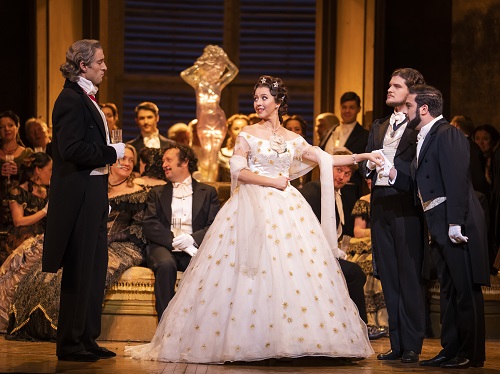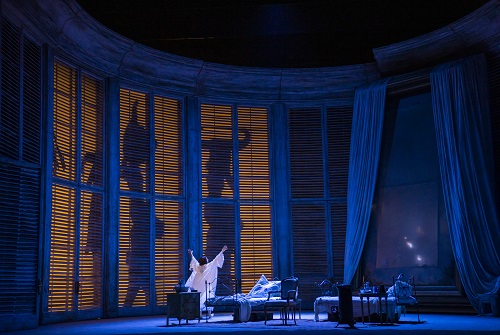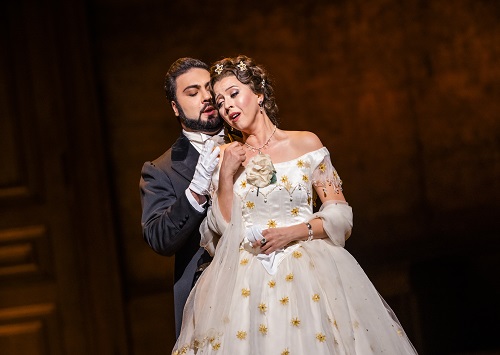Given the tubercular demise of Verdi’s tragic heroine, it’s tempting to describe the ROH’s latest reprise of Richard Eyre’s 1994 production of Verdi’s La traviata in pandemic terms – in which case this would be the first wave of two scheduled this Season, and the first variant of six, with Pretty Yende, Angel Blue and Hrachuhí Bassénz due to embody the eponymous courtesan in spring 2022, following Kristina Mkhitaryan, Anush Hovhannisyan and, opening this autumn run, Lisette Oropesa.
To labour the metaphor, Richard Eyre’s 1994 production has been endemic at Covent Garden for almost 30 years now, and on opening night, enjoying the naturalness with which the drama unfolded, spectacle alternating with sparsity, dazzling glitter draining into ghostliness, it was easy to understand why Eyre’s traditional approach has given, and will continue to offer, so much pleasure. It’s quite simply terrific theatre. Bob Crowley’s handsome, towering sets push the protagonists to the front of the stage, enhancing our proximity to, even complicity in, the protagonist’s suffering – though I still feel that in the opening soirée scene the space carved out by the graciously curving walls is too confining, crushing together the partygoers and stifling the social effervescence that should bubble up from the flowing champagne. Jean Kalman’s atmospheric lighting enhances the juxtapositions inherent to the dreadful disease which afflicts the heroine – the ‘co-existence of lassitude and hoarseness with bursts of excitement and “foolish gaiety”’ as described by Christopher Wintle in an eloquent and discerning programme article which notes that this dichotomy informs everything in the music of La traviata.

So, Kalman floods Violetta’s salon with the golden glow of autumnal late-August, a warmth which dissipates into a wan wintriness epitomised by the stark white walls – denuded of their art which must be sold to keep creditors at bay – of the country house where Violetta and Alfredo retreat from Parisian pleasures. In the second scene of Act 2, self-sacrifice sees Violetta return to the red glare of public scrutiny, the flood of colour both visual and musical as real gypsies and guests dressed as matadors entertain Flora’s guests. Violetta’s black gown, replacing her former white elegance, is a potent sign of both her physical decline and moral anguish. And, by the final Act, the palette, like her life, is monochrome. Paradoxically, the most intimate moments take place in the most ‘open’ set, but the bareness of the stage only confirms the isolation and loneliness of the bed-ridden consumptive, despite the kind ministrations of Annina (Renata Skarelyte) and Doctor Grenvil (Blaise Malaba), and the reappearance of Alfredo and his father, repentant, too late. Frail, faltering, the heroine inexorably fades: a mirror – decaying but domineering – and looming, out-sized shadows confirm that all that remains are reminiscences and regret.
If Verdi’s drama sweeps one up, like the lurching waltz of death which dances Violetta to her inevitable fate, then on this occasion conductor Antonello Manacorda made a considerable contribution to the opera’s persuasive cogency. There was a lovely spaciousness about Manacorda’s reading which allowed both the musical colours to shine and the singers’ expressivity to bloom. The pacing of the whole was superb: I don’t think I’ve ever been so aware of the ghastly ‘thud’ of death that forces its way into the final act.

This run of the production reunites Lisette Oropesa, in the title role, and Liparit Avetisyan, as Alfredo Germont, just a few weeks since the full re-opening of the House in Oliver Mears’ production of Rigoletto. Oropesa’s soprano is not the most richly coloured or full, but she controls it with astonishing confidence and subtlety, and in Act 1 she made a virtue of vocal lightness. The floridity really meant something; and, no matter how pinpoint accurate the coloratura, beneath the elegance of the portrayal one sensed a tremor, an inner unrest and unease. Oropesa made the gaiety ripple with both sophisticated élan and desperation; she made us sense the frailty beneath the bravura, understand that it is the knowledge of such frailty that fuels the attack. Trying to shake away her doubts, “Follie! Follie! Delirio vano è questo”, she committed herself to revelry but the repetitions of “gioir” took on a manic tint, even as they sparkled so beautifully. The rock-steady precision of the climactic Eb at the close of ‘Sempre libre’ seemed borne aloft on a crest of hysteria, and served to confirm the inescapable outcome of Violetta’s recklessness.
In Act 2, Oropesa found a little more colour and warmth, making us feel, through her command of the legato line and her sensitivity to the text, her very human struggle to deny mortality and fate. She paced the tension brilliantly, revealing the anguish of love relinquished and a heart broken. Perhaps she cannot rely on an innate lyrical quality to convey Violetta’s passion and despair, but Oropesa is a natural singing-actress, and the pathos of Act 3 was heart-wrenching. The expressive details were emphasised but not exaggerated, even if she looked as hollowed out and haunted as a phantom. Indeed, this fragile Violetta was so evidently close to death that it was painful to endure her memories and her prayer, even as it was beautiful to hear them. In ‘Addio del passato’, despite the stunning soaring lines, somehow Oropesa seemed to intimate a body on the cusp of breathless collapse. Even the depiction of the momentary, delusory belief in recovery, known as spes phthisica, was more convincing than I remembered from previous performances, the surge of adrenaline sending the languishing Violetta spinning around the room, only to slump, lifeless, into Alfredo’s well-timed embrace.

Liparit Avetisyan was an ardent, suave Alfredo. I loved the way he emphasised the shapeliness of the brindisi, and he brought forth a truly bitter anger in the gambling scene. His acting is perhaps a little too ‘safe’ to convey the impulsiveness of Alfredo’s character. But, Avetisyan and Oropesa rose to expressive heights in their duets, ‘in tune’ in all senses of the word and singing with real freedom. In ‘Un dì, felice, eterea’, for example, there was a true sense of ease and joy in the rising arpeggio motifs, the merest rubato, a light lingering at the top: “delizia alcor” indeed. And, at moments like this, Manacorda followed his singers sensitively, pushing forward compellingly as required.
I wasn’t that taken by Christian Gerhaher’s Giorgio Germont. He seemed a rather unforgiving father, heartlessly bullying Violetta, roughly clouting his rebellious son. We’re used to hearing Gerhaher’s elegant baritone in lieder recitals but here he was gruffer, no patrician, and it was harder to believe in Germont’s contriteness at the close. The minor roles were all well sung and convincingly acted. Stephanie Wake-Edwards was a light-hearted Flora Bervoix, Jeremy White a self-confident Marquis D’obigny, Yuriy Yurchuk conveyed the proud Baron Douphol’s humiliation, and Egor Zhuravskii was a particularly elegant Gastone de Letorières.
This was Lisette Oropesa’s night, though, as the standing ovation that the whole House afforded her at the final curtain attested. Violetta dominates the opera, barely leaving the stage. Oropesa communicated the courtesan’s essential aristocracy and dignity as powerfully as she conveyed her sorrow and suffering. As the gentleman sitting just behind me cried out repeatedly during the performance, “Brava!”
Claire Seymour
Violetta Valéry – Lisette Oropesa, Alfredo Germont – Liparit Avetisyan, Giorgio Germont – Christian Gerhaher, Flora Bervoix – Stephanie Wake-Edwards, Marquis D’obigny – Jeremy White, Baron Douphol – Yuriy Yurchuk, Doctor Grenvil – Blaise Malaba, Gastone de Letorières – Egor Zhuravskii, Annina – Renata Skarelyte, Giuseppe – Andrew Macnair, Messenger – Dominic Barrand, Servant – Thomas Barnard; Director – Richard Eyre, Conductor – Antonello Manacorda, Revival Director – Pedro Ribeiro, Designer – Bob Crowley, Lighting designer – Jean Kalman, Director of movement – Jane Gibson, Orchestra and Chorus of the Royal Opera House (Chorus director, William Spaulding.
Royal Opera House, Covent Garden, London; Wednesday 27th October 2021.
ABOVE: Lisette Oropesa ©2021 ROH. Photo by Tristam Kenton